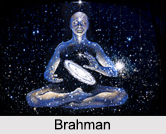 Brahman is that from which beings are born, in which they live when they are born, and that into which they enter at their death. Matter cannot account for the life phenomena. Matter does not hold the secret of life, though life cannot exist without matter. There is something in life which enables it to absorb and transmute the inorganic elements. This something is the vital principle. It is the principle which pervades the universe and binds human beings with the rest of creation.
Brahman is that from which beings are born, in which they live when they are born, and that into which they enter at their death. Matter cannot account for the life phenomena. Matter does not hold the secret of life, though life cannot exist without matter. There is something in life which enables it to absorb and transmute the inorganic elements. This something is the vital principle. It is the principle which pervades the universe and binds human beings with the rest of creation.
Each higher principle is more concrete and inclusive than the lower one, and therefore Ananda, which is Brahman, is the most inclusive of all. From it all things flow, by it all things are sustained and into it all things are dissolved. The different parts, the mineral
world, the plant life, the animal kingdom and the human society, are not related to the highest in any abstract or mechanical way. They are one in and through that which is universal about them. All parts in the universe share in the light of this universal spirit and possess specific features on account of the special functions which they have to perform. The parts are not self-subsistent factors, but are dependent aspects of the one.
Relation between Brahman and Atman
It has been declared that the Brahman and the Atman, the cosmic and the psychical principles, are looked upon as identical; Brahman is Atman. The infinite is not beyond the finite but in the finite. The different conceptions of Brahman correspond to the different ideas of the Atman, and vice versa. The highest Brahman which is Ananda is just Atman, as realised in the 4th or the Turiya state. There the object and the subject are one. The seer, the Seeing Eye and the object seem merging together in one whole. Brahman is viewed as the self-conscious Ishwar with a force opposed to him. When the Atman is identified with the mental and vital self of man (manas and prana), Brahman is reduced to the Hiranyagarbha or the cosmic soul, which comes between the Ishwar and the soul of man. This Hiranyagarbha is looked upon as related to the universe in the same way as the individual soul is related to its body.
Different Natures of Brahman
The conscious totality of all effects is Brahma or Hiranyagarbha. It is not radically different from the Brahman. Brahman is the simple, individual, absolutely self-identical, One, without a second. Once He is looked as the creator or Ishwar, again as the Created or Hiranyagarbha. Even He is the source of Brahma. The entire objective universe is sustained by this knowing subject. While the individual subjects pass away, he lives contemplating the world. When one identifies the Atman with one"s body, Brahman becomes the Cosmos or the Virat. Virat is the all, the hypostatisation of the conception of the world as a whole. It is the totality of things, the sum of all existence. Brahma is the same manifested in the subtle matter of the universe. The supreme self beyond cause and effect is the Brahman, but when it becomes self-conscious with a non-ego opposed evolves the Ishwar.
Brahman is infinite not in the sense that it excludes the finite, but in the sense that it is the ground of all finites. The word Brahman means growth, and is suggestive of life, motion and progress, and not death, stillness or stagnation. The ultimate reality is described as Sat, Cit and Ananda which are existence, consciousness and bliss respectively.
Hence it can be concluded saying that Brahman is the ultimate reality of life and is synonymous with the Atman. It has been claimed by the philosophical texts that realisation of the Brahman gives an individual the Absolute Bliss.




















